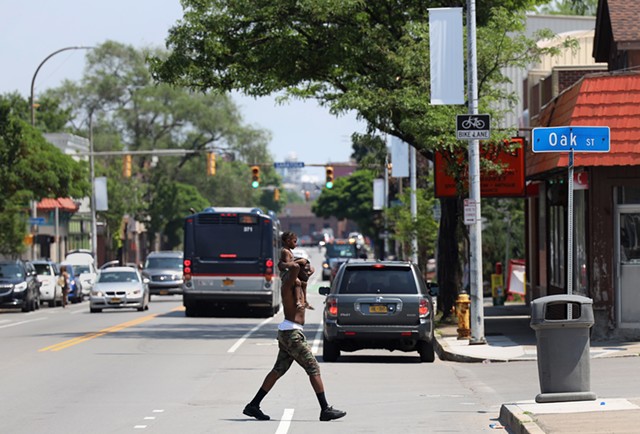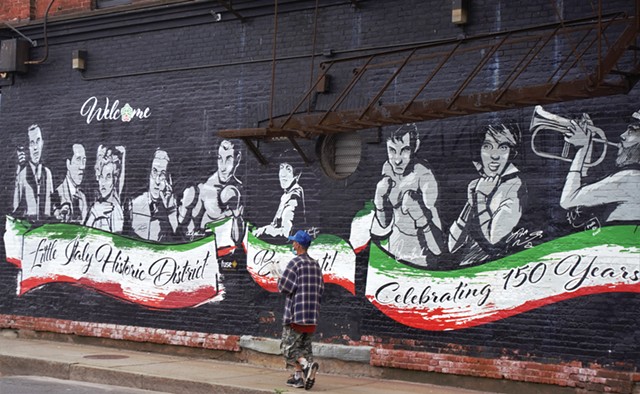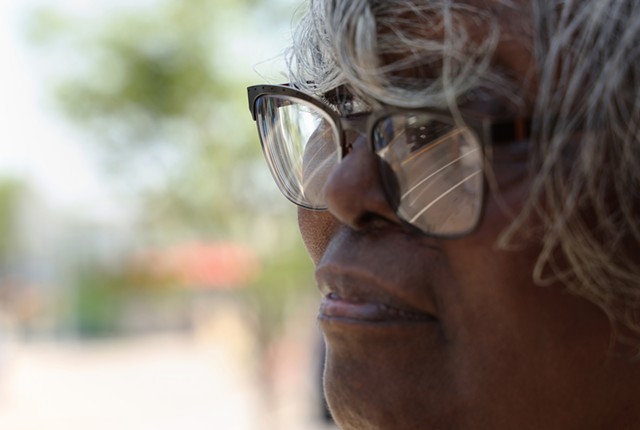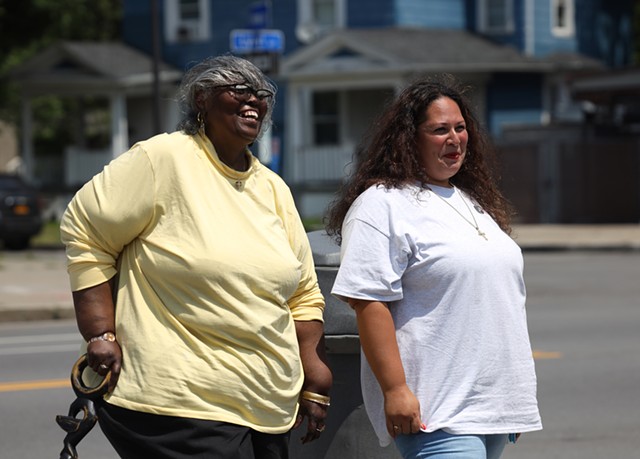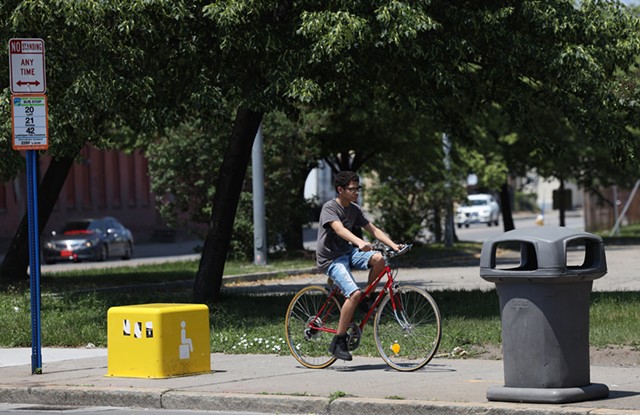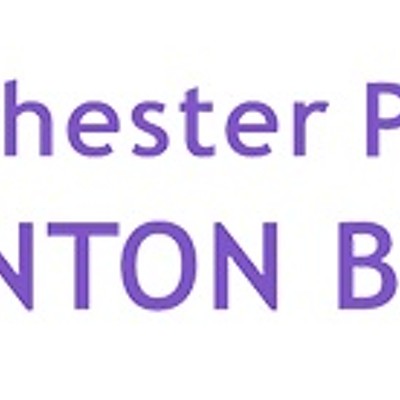Lyell Avenue, a very 'Little Italy,' and a neighborhood at a crossroads
By Gino Fanelli @GinoFanelli[
{
"name": "500x250 Ad",
"insertPoint": "5",
"component": "15667920",
"parentWrapperClass": "",
"requiredCountToDisplay": "1"
}
]
The Edgerton neighborhood on the western banks of the Genesee River between Lyell and Driving Park avenues is a study in contradictions.
On one hand, Lyell Avenue is haunted by boarded-up storefronts, open-air drug deals, and prostitution. On the other, signs that residents are making the best of a troubled neighborhood are everywhere.
Southeast Asian refugees who call the neighborhood home picnic in their yards. The walking paths of Jones Square Park are bedecked in vibrant pastel chalk. A father carries his young daughter on his shoulders to the local convenience store.
Lydia Rivera, vice president of the Edgerton Area Neighborhood Association, recalled that her work in the neighborhood began with the simple act of picking up trash on Emerson Street.
“I ended up just going out there every morning, picking up garbage, and [neighbors] would look at me wondering what I was doing,” Rivera said. “One day, someone finally asked me what I was doing, and I said, ‘I’m picking up the garbage, our kids deserve better than this.’”
Edgerton has for years been challenged by poverty, violence, drugs, and a lack of private investment. In the past several years, it has also endured an identity crisis.
On the brick wall of the Flatiron Building at the intersection of State Street and Lyell Avenue is a mural featuring Italian-American icons with no link to the neighborhood or the city — performers Frank Sinatra and Liza Minnelli, the late Supreme Court Justice Antonin Scalia, and boxer Rocky Marciano. It welcomes visitors to the “Little Italy Historic District — Celebrating 150 Years.”
That mural was the handiwork of Silvano Orsi, a lawyer from Gates whose quest to establish a “Little Italy” in the Rochester region in recent years has been something of a personal crusade. He tried to fashion one out of a commercial strip at Lyell Avenue and Spencerport Road in Gates. When that didn’t work, he looked eastward to the city.
That was almost five years ago. This spring, Orsi announced that his Little Italy Association, which re-introduced an Italian Festival to downtown after a 30-year absence, would temporarily suspend its operations as he battled what he termed a “serious health condition.” Orsi did not respond to several requests from CITY for comment for this story.
“We did a lot of good, we raised awareness, and we helped a lot of people — feeding hundreds of needy families and successfully bringing back the Italian Festival and wonderful Italian culture to downtown Rochester after more than three decades,” Orsi said in a statement. “We helped clean up the Lyell area, and we went to bat many times for city residents and businesses, standing against crime in the area, and we also helped save the city’s soccer stadium. At least I can say I tried. For that I will always be a neighborhood champion.”
To some longtime Edgerton residents, though, he was a neighborhood terror.
In the process of carving a community centered on Italian culture out of Edgerton, Orsi made enemies of leaders in the neighborhood, who say he used his “Little Italy” social media platforms to settle vendettas and level personal attacks against people with whom he disagreed.
When Orsi was left out of a meeting of community leaders and representatives of Zweigle’s about the company’s expansion plans in the neighborhood, he accused the director of the city’s Neighborhood Service Centers, Daisy Algarin, of excluding him and posted on his association’s Facebook page a tax warrant filed against her and her husband by the state Department of Taxation and Finance.
The warrant, which is the same as a lien and not criminal, amounted to $282 for unpaid taxes from six years earlier. He sent the information to local media, implying that the couple were tax cheats.
The president of the Edgerton Area Neighborhood Association, Debbie Smith, said Orsi started a social media campaign against her, accusing her of being a racist and calling him a “cracker,” which she denies doing.
Rivera and Smith said that when they didn’t support Orsi’s pursuit of a $20,000 grant to build a statue of Frances Xavier Cabrini, the patron saint of immigrants, they became his target.
“He terrorized the neighborhood and its leaders,” Rivera said. “I have countless emails I’ve received from him slandering me.”
A (VERY) LITTLE ITALY AND (NOT SO) HISTORIC DISTRICT
So how did a man from Gates establish an historic district in the city of Rochester? The simple answer is he didn’t.
In the mid-2010s, Orsi found an ally in former City Councilmember Molly Clifford, who introduced him to Mayor Lovely Warren. A dinner between them was arranged. Multiple sources familiar with the meeting said Orsi served gnocchi and pitched the idea of reviving the Italian Festival, which had been a fixture of the city’s festival scene until 1986.
He formed the Little Italy Association of Rochester nonprofit in 2016, and debuted the revived festival in 2017. It continued until being stymied by the pandemic in 2020. A date for the event this year has not been announced.
In June 2019, the City Council adopted a symbolic proclamation that recognized the Lyell Avenue corridor within the Edgerton and Brown Square neighborhoods the “Little Italy Historic District.”
Orsi heralded the recognition as a victory. But his celebration was premature. The City Council does not designate historic districts. That is a job for the state’s Historic Preservation Office. The city and state keep a roster of local historic preservation districts, and Orsi’s “Little Italy” is nowhere on either list.
“(The city) does those designations because we like to do those whenever we have festivals,” Algarin said. “The mayor might say, ‘Hey, could you issue a proclamation, for say, the Corn Hill Festival?’ I have a proclamation in my own name. These are symbolic gestures city governments do to acknowledge citizens and their work.”
When asked if the city’s designation carries any weight whatsoever, Algarin laughed.
“This is like Cuomo saying it’s Daisy Algarin Day, or someone giving Daisy the key to the city,” Algarin said. “We have how many keys to the city? No one has a real key to the city. You can’t just go around opening doors.”
Orsi, 53, grew up near Lyell Avenue at a time when the strip had an array of Italian-American businesses. Most of them have shuttered. Roncone’s Italian Restaurant, which opened in 1937 and closed in 2019, was the last Italian restaurant in the neighborhood.
Today, whatever Italian influence there was once was in Edgerton has all but vanished.
A 2019 Lyell Avenue Corridor study commissioned by the city noted the push to brand Lyell Avenue as “Little Italy,” but cautioned against labeling the area as being defined by a singular cultural heritage. “This draws on the district’s roots,” the study read, “although there are no longer many ethnic Italian businesses, though there are many from Asian, Hispanic, and other ethnic communities.”
Orsi subsequently filed a complaint with the federal Department of Justice’s Civil Rights Division against the city, claiming it had neglected the “Little Italy Historic District” and deliberately left it blighted. His complaint cited the study, charging erroneously that the study stated there were “no longer any Italian-American ethnic businesses.”
Of the 2,474 people who live in the census tracts that cover the neighborhood, as few as 48 and as many 264 of them claim Italian ancestry, according to the U.S. Census Bureau. The disparity accounts for a statistical margin of error. By comparison, the bureau estimates that as many as 1,152 neighborhood residents are Black.
The Little Italy Association’s tax filing states that the district is where “Rochester, NY’s Little Italy began and later expanded in its historic heyday.” But it is worth asking whether a “Little Italy” moniker was ever appropriate for Edgerton.
The only reference to a “Little Italy” in Rochester appears to be a mention in a 1904 Democrat and Chronicle article that slapped the nickname on Allen Street, several blocks south of the present-day district.
Certainly many Italians did immigrate to the Edgerton area during the 19th and 20th centuries. The largest number settled in neighborhoods around Lyell Avenue and Jay Street to the south. Some 1935 descriptions of neighborhoods around Lyell Avenue, drafted by the federal Home Owners' Loan Corporation and used in redlining, noted increasing numbers of Italians, but also stated that Germans had settled the corridor.
But there were also huge contingents of Italian immigrants in other pockets of the city.
A remarkably bigoted Democrat and Chronicle article from 1879 referred to several “savage” Italian neighborhoods, and identified St. Paul Street and the surrounding neighborhood, then called Dublin, as the city’s main Italian colony.
CRIME, DEVELOPMENT, AND SEARCHING FOR HOPE
Strolling down Lyell Avenue on a recent sunny day, Rivera and Smith described a neighborhood facing challenges.
“Stability is the issue that is really hard,” Rivera said. “We see a lot of the drugs, the mental health issues, it all can affect your stability. Not everyone in the neighborhood is like that, but it is everywhere.”
Crime in the Edgerton area remains top of mind for residents. This year to date, two murders, two dozen aggravated assaults, and a slew of burglaries, larcenies, and car thefts have taken place in the neighborhood, according to Rochester Police Department data.
One recent Thursday evening, a handful of locals gathered in the Edgerton R-Center for the neighborhood association’s monthly meeting. Crime was on every member’s mind, as was its effect on the neighborhood’s reputation.
“How many times do you listen to these jocks on the morning radio shows, and they’re like, ‘Hey, where are you going to pick up a girl? Lyell Avenue. Where are you going to get a piece of crack? Lyell Avenue,’” association member Gary Goldstein said.
Prostitution and drugs are not a new issue in the neighborhood by any stretch. When the crack epidemic was in full swing in the 1980s, the area around Jones Square Park was something of a red light district. It was there that serial killer Arthur Shawcross sought his victims.
The problems of the past still hang over the neighborhood.
“Its reputation may be the greatest challenge for the corridor, which is perceived to have a high rate of criminal activity including drug use and prostitution,” read the city’s Lyell Avenue corridor study. “Adult businesses have located on Lyell Avenue that reinforce the negative image. Adjacent neighborhoods have many vacant lots or boarded-up homes.”
Long-time Edgerton residents acknowledge the issues and say they are nuanced. Often, it’s small things that make a difference. Rivera pointed to new trash cans on the street as a welcome addition to the neighborhood. Before their arrival, trash cans were few and far between.
But there is plenty of work left to be done to bring the neighborhood together and create change. Tammi Herron, the administrator of the Northwest Quadrant Neighborhood Service Center, said change follows a change of “mindset” about what it means to be a neighborhood.
“Since prior to the pandemic, my motto has been let’s become neighbors and not just neighborhoods,” Herron said. “We have to get back to being neighbors. . . . We work better in numbers, because you get a consensus of what we, as a community, want.”
Herron said the neighborhood lacks basic resources. Most corner stores don’t stock healthy food or fresh produce. The only laundromat in the area is farther west on Lyell toward Mt. Read Boulevard. No urgent care centers are accessible.
“We need people to open up businesses,” Herron said. “. . .The best way to do that is to put things in neighborhoods that people actually want. A good laundromat, a store that sells fresh produce, good quality markets like a fish market, cleaners. When you actually put those kinds of amenities in a community where people don’t have to travel outside, they’re more prone to keeping their money in the community.”
Herron and neighborhood leaders have been trying to get more residents involved in the Edgerton Area Neighborhood Association. Herron said that, ideally, she’d like to see each person who shows up to the association’s meetings bring a neighbor.
The more people who attend, the more voices are heard, and the more likely it is for city resources to be allocated to the neighborhood, leaders emphasized.
“Sometimes, people are waiting just to be asked,” Herron said.
FLEXING MUSCLES, FILLING A VOID
With Orsi and his Little Italy Association retreating, at least temporarily, from trying to define the neighborhood, there is room for groups like the Edgerton Area Neighborhood Association to play a more assertive role in forging the future.
On a Wednesday in late June, officials removed the Little Italy Historic District page from the city's website. Algarin, the director of the Neighborhood Service Centers, said the group had repeatedly violated a code of conduct which forbids neighborhood groups from denigrating, insulting, or disrespecting other groups or people.
"I've been working for the city for 21 years, I've never had to do anything like this," Algarin said. "...my jaw drops."
Algarin said beyond just the behavior of Orsi on social media, the demands of the group and its somewhat clandestine nature also made it stand out from other neighborhood groups.
“When we put his page up on our website, he was doing things for the community,” Algarin said. “But when things don’t go his way, like when he wants free police for events and we can’t afford that, you get put on his doo-doo list.
“I don’t know anyone who belongs to the Little Italy Association to be honest,” she went on. “I know that people in the other groups, like Edgerton, Lyell-Otis, JOSANA, they keep me informed.”
Following the removal of the district's page from the city website, Orsi released a statement accusing the city of violating the constitutional rights of Italian-Americans. The statement says the group is considering a civil rights lawsuit against the city.
"The city website promotes and includes other culture's historic neighborhoods like "Dutchtown" (old German neighborhood) and the El Camino neighborhood with La Marketa International Plaza (Hispanic Cultural hubs) but excludes Italian-Americans," the statement reads.
Smith and Rivera are optimistic about forging Edgerton’s future out of the shadow of “Little Italy” and said they want to help build it into a neighborhood that thrives with access to crucial services, good schools, and higher rates of homeownership.
They see work to be done and don’t want to get bogged down in drama over a neighborhood group.
“When you do something to make it alive and people are helping each other, and they say, ‘Oh, I might try that,’ or, ‘I’ll help you out with that one night,’ it brings it back alive again,” Smith said. “You ever notice if you’re out cleaning your yard, someone might see that and think, ‘You know what, I’ll go out and do that too?’ It’s a beautiful reaction.”
Gino Fanelli is a CITY staff writer. He can be reached at (585) 775-9692 or [email protected].
On one hand, Lyell Avenue is haunted by boarded-up storefronts, open-air drug deals, and prostitution. On the other, signs that residents are making the best of a troubled neighborhood are everywhere.
Southeast Asian refugees who call the neighborhood home picnic in their yards. The walking paths of Jones Square Park are bedecked in vibrant pastel chalk. A father carries his young daughter on his shoulders to the local convenience store.
Lydia Rivera, vice president of the Edgerton Area Neighborhood Association, recalled that her work in the neighborhood began with the simple act of picking up trash on Emerson Street.
“I ended up just going out there every morning, picking up garbage, and [neighbors] would look at me wondering what I was doing,” Rivera said. “One day, someone finally asked me what I was doing, and I said, ‘I’m picking up the garbage, our kids deserve better than this.’”
Edgerton has for years been challenged by poverty, violence, drugs, and a lack of private investment. In the past several years, it has also endured an identity crisis.
On the brick wall of the Flatiron Building at the intersection of State Street and Lyell Avenue is a mural featuring Italian-American icons with no link to the neighborhood or the city — performers Frank Sinatra and Liza Minnelli, the late Supreme Court Justice Antonin Scalia, and boxer Rocky Marciano. It welcomes visitors to the “Little Italy Historic District — Celebrating 150 Years.”
That mural was the handiwork of Silvano Orsi, a lawyer from Gates whose quest to establish a “Little Italy” in the Rochester region in recent years has been something of a personal crusade. He tried to fashion one out of a commercial strip at Lyell Avenue and Spencerport Road in Gates. When that didn’t work, he looked eastward to the city.
That was almost five years ago. This spring, Orsi announced that his Little Italy Association, which re-introduced an Italian Festival to downtown after a 30-year absence, would temporarily suspend its operations as he battled what he termed a “serious health condition.” Orsi did not respond to several requests from CITY for comment for this story.
“We did a lot of good, we raised awareness, and we helped a lot of people — feeding hundreds of needy families and successfully bringing back the Italian Festival and wonderful Italian culture to downtown Rochester after more than three decades,” Orsi said in a statement. “We helped clean up the Lyell area, and we went to bat many times for city residents and businesses, standing against crime in the area, and we also helped save the city’s soccer stadium. At least I can say I tried. For that I will always be a neighborhood champion.”
To some longtime Edgerton residents, though, he was a neighborhood terror.
In the process of carving a community centered on Italian culture out of Edgerton, Orsi made enemies of leaders in the neighborhood, who say he used his “Little Italy” social media platforms to settle vendettas and level personal attacks against people with whom he disagreed.
When Orsi was left out of a meeting of community leaders and representatives of Zweigle’s about the company’s expansion plans in the neighborhood, he accused the director of the city’s Neighborhood Service Centers, Daisy Algarin, of excluding him and posted on his association’s Facebook page a tax warrant filed against her and her husband by the state Department of Taxation and Finance.
The warrant, which is the same as a lien and not criminal, amounted to $282 for unpaid taxes from six years earlier. He sent the information to local media, implying that the couple were tax cheats.
The president of the Edgerton Area Neighborhood Association, Debbie Smith, said Orsi started a social media campaign against her, accusing her of being a racist and calling him a “cracker,” which she denies doing.
Rivera and Smith said that when they didn’t support Orsi’s pursuit of a $20,000 grant to build a statue of Frances Xavier Cabrini, the patron saint of immigrants, they became his target.
“He terrorized the neighborhood and its leaders,” Rivera said. “I have countless emails I’ve received from him slandering me.”
A (VERY) LITTLE ITALY AND (NOT SO) HISTORIC DISTRICT
So how did a man from Gates establish an historic district in the city of Rochester? The simple answer is he didn’t.
In the mid-2010s, Orsi found an ally in former City Councilmember Molly Clifford, who introduced him to Mayor Lovely Warren. A dinner between them was arranged. Multiple sources familiar with the meeting said Orsi served gnocchi and pitched the idea of reviving the Italian Festival, which had been a fixture of the city’s festival scene until 1986.
He formed the Little Italy Association of Rochester nonprofit in 2016, and debuted the revived festival in 2017. It continued until being stymied by the pandemic in 2020. A date for the event this year has not been announced.
In June 2019, the City Council adopted a symbolic proclamation that recognized the Lyell Avenue corridor within the Edgerton and Brown Square neighborhoods the “Little Italy Historic District.”
Orsi heralded the recognition as a victory. But his celebration was premature. The City Council does not designate historic districts. That is a job for the state’s Historic Preservation Office. The city and state keep a roster of local historic preservation districts, and Orsi’s “Little Italy” is nowhere on either list.
“(The city) does those designations because we like to do those whenever we have festivals,” Algarin said. “The mayor might say, ‘Hey, could you issue a proclamation, for say, the Corn Hill Festival?’ I have a proclamation in my own name. These are symbolic gestures city governments do to acknowledge citizens and their work.”
When asked if the city’s designation carries any weight whatsoever, Algarin laughed.
“This is like Cuomo saying it’s Daisy Algarin Day, or someone giving Daisy the key to the city,” Algarin said. “We have how many keys to the city? No one has a real key to the city. You can’t just go around opening doors.”
Orsi, 53, grew up near Lyell Avenue at a time when the strip had an array of Italian-American businesses. Most of them have shuttered. Roncone’s Italian Restaurant, which opened in 1937 and closed in 2019, was the last Italian restaurant in the neighborhood.
Today, whatever Italian influence there was once was in Edgerton has all but vanished.
A 2019 Lyell Avenue Corridor study commissioned by the city noted the push to brand Lyell Avenue as “Little Italy,” but cautioned against labeling the area as being defined by a singular cultural heritage. “This draws on the district’s roots,” the study read, “although there are no longer many ethnic Italian businesses, though there are many from Asian, Hispanic, and other ethnic communities.”
Orsi subsequently filed a complaint with the federal Department of Justice’s Civil Rights Division against the city, claiming it had neglected the “Little Italy Historic District” and deliberately left it blighted. His complaint cited the study, charging erroneously that the study stated there were “no longer any Italian-American ethnic businesses.”
Of the 2,474 people who live in the census tracts that cover the neighborhood, as few as 48 and as many 264 of them claim Italian ancestry, according to the U.S. Census Bureau. The disparity accounts for a statistical margin of error. By comparison, the bureau estimates that as many as 1,152 neighborhood residents are Black.
The Little Italy Association’s tax filing states that the district is where “Rochester, NY’s Little Italy began and later expanded in its historic heyday.” But it is worth asking whether a “Little Italy” moniker was ever appropriate for Edgerton.
The only reference to a “Little Italy” in Rochester appears to be a mention in a 1904 Democrat and Chronicle article that slapped the nickname on Allen Street, several blocks south of the present-day district.
Certainly many Italians did immigrate to the Edgerton area during the 19th and 20th centuries. The largest number settled in neighborhoods around Lyell Avenue and Jay Street to the south. Some 1935 descriptions of neighborhoods around Lyell Avenue, drafted by the federal Home Owners' Loan Corporation and used in redlining, noted increasing numbers of Italians, but also stated that Germans had settled the corridor.
But there were also huge contingents of Italian immigrants in other pockets of the city.
A remarkably bigoted Democrat and Chronicle article from 1879 referred to several “savage” Italian neighborhoods, and identified St. Paul Street and the surrounding neighborhood, then called Dublin, as the city’s main Italian colony.
CRIME, DEVELOPMENT, AND SEARCHING FOR HOPE
Strolling down Lyell Avenue on a recent sunny day, Rivera and Smith described a neighborhood facing challenges.
“Stability is the issue that is really hard,” Rivera said. “We see a lot of the drugs, the mental health issues, it all can affect your stability. Not everyone in the neighborhood is like that, but it is everywhere.”
Crime in the Edgerton area remains top of mind for residents. This year to date, two murders, two dozen aggravated assaults, and a slew of burglaries, larcenies, and car thefts have taken place in the neighborhood, according to Rochester Police Department data.
One recent Thursday evening, a handful of locals gathered in the Edgerton R-Center for the neighborhood association’s monthly meeting. Crime was on every member’s mind, as was its effect on the neighborhood’s reputation.
“How many times do you listen to these jocks on the morning radio shows, and they’re like, ‘Hey, where are you going to pick up a girl? Lyell Avenue. Where are you going to get a piece of crack? Lyell Avenue,’” association member Gary Goldstein said.
Prostitution and drugs are not a new issue in the neighborhood by any stretch. When the crack epidemic was in full swing in the 1980s, the area around Jones Square Park was something of a red light district. It was there that serial killer Arthur Shawcross sought his victims.
The problems of the past still hang over the neighborhood.
“Its reputation may be the greatest challenge for the corridor, which is perceived to have a high rate of criminal activity including drug use and prostitution,” read the city’s Lyell Avenue corridor study. “Adult businesses have located on Lyell Avenue that reinforce the negative image. Adjacent neighborhoods have many vacant lots or boarded-up homes.”
Long-time Edgerton residents acknowledge the issues and say they are nuanced. Often, it’s small things that make a difference. Rivera pointed to new trash cans on the street as a welcome addition to the neighborhood. Before their arrival, trash cans were few and far between.
But there is plenty of work left to be done to bring the neighborhood together and create change. Tammi Herron, the administrator of the Northwest Quadrant Neighborhood Service Center, said change follows a change of “mindset” about what it means to be a neighborhood.
“Since prior to the pandemic, my motto has been let’s become neighbors and not just neighborhoods,” Herron said. “We have to get back to being neighbors. . . . We work better in numbers, because you get a consensus of what we, as a community, want.”
Herron said the neighborhood lacks basic resources. Most corner stores don’t stock healthy food or fresh produce. The only laundromat in the area is farther west on Lyell toward Mt. Read Boulevard. No urgent care centers are accessible.
“We need people to open up businesses,” Herron said. “. . .The best way to do that is to put things in neighborhoods that people actually want. A good laundromat, a store that sells fresh produce, good quality markets like a fish market, cleaners. When you actually put those kinds of amenities in a community where people don’t have to travel outside, they’re more prone to keeping their money in the community.”
Herron and neighborhood leaders have been trying to get more residents involved in the Edgerton Area Neighborhood Association. Herron said that, ideally, she’d like to see each person who shows up to the association’s meetings bring a neighbor.
The more people who attend, the more voices are heard, and the more likely it is for city resources to be allocated to the neighborhood, leaders emphasized.
“Sometimes, people are waiting just to be asked,” Herron said.
FLEXING MUSCLES, FILLING A VOID
With Orsi and his Little Italy Association retreating, at least temporarily, from trying to define the neighborhood, there is room for groups like the Edgerton Area Neighborhood Association to play a more assertive role in forging the future.
On a Wednesday in late June, officials removed the Little Italy Historic District page from the city's website. Algarin, the director of the Neighborhood Service Centers, said the group had repeatedly violated a code of conduct which forbids neighborhood groups from denigrating, insulting, or disrespecting other groups or people.
"I've been working for the city for 21 years, I've never had to do anything like this," Algarin said. "...my jaw drops."
Algarin said beyond just the behavior of Orsi on social media, the demands of the group and its somewhat clandestine nature also made it stand out from other neighborhood groups.
“When we put his page up on our website, he was doing things for the community,” Algarin said. “But when things don’t go his way, like when he wants free police for events and we can’t afford that, you get put on his doo-doo list.
“I don’t know anyone who belongs to the Little Italy Association to be honest,” she went on. “I know that people in the other groups, like Edgerton, Lyell-Otis, JOSANA, they keep me informed.”
Following the removal of the district's page from the city website, Orsi released a statement accusing the city of violating the constitutional rights of Italian-Americans. The statement says the group is considering a civil rights lawsuit against the city.
"The city website promotes and includes other culture's historic neighborhoods like "Dutchtown" (old German neighborhood) and the El Camino neighborhood with La Marketa International Plaza (Hispanic Cultural hubs) but excludes Italian-Americans," the statement reads.
Smith and Rivera are optimistic about forging Edgerton’s future out of the shadow of “Little Italy” and said they want to help build it into a neighborhood that thrives with access to crucial services, good schools, and higher rates of homeownership.
They see work to be done and don’t want to get bogged down in drama over a neighborhood group.
“When you do something to make it alive and people are helping each other, and they say, ‘Oh, I might try that,’ or, ‘I’ll help you out with that one night,’ it brings it back alive again,” Smith said. “You ever notice if you’re out cleaning your yard, someone might see that and think, ‘You know what, I’ll go out and do that too?’ It’s a beautiful reaction.”
Gino Fanelli is a CITY staff writer. He can be reached at (585) 775-9692 or [email protected].
Latest in News
More by Gino Fanelli
-
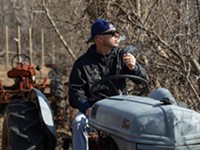
These small cannabis farmers say New York's legal weed rollout is ruining their lives
Mar 21, 2024 -
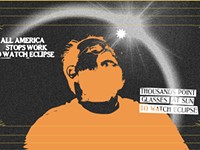
Man shakes fist at sun
Mar 15, 2024 -

Finger Lakes in a can, by way of Hollywood
Feb 13, 2024 - More »
